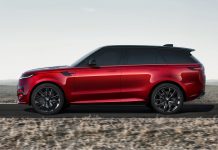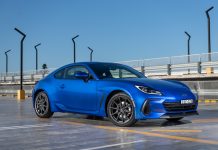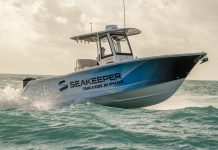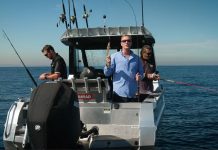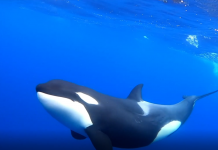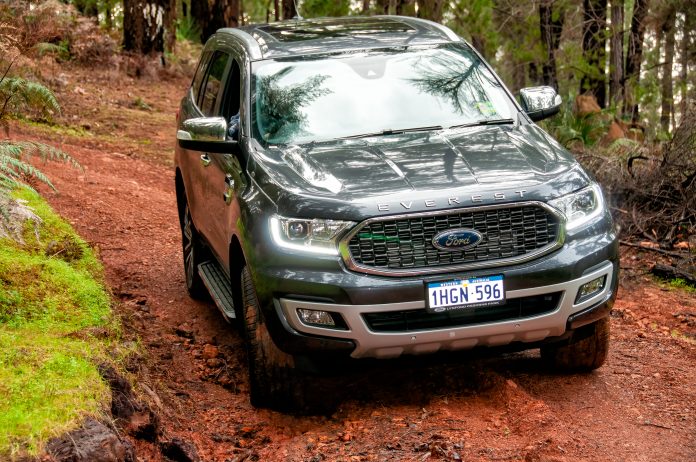When you have an impressive and popular dual cab utility, it makes good business sense to amortise the R&D that’s gone into that vehicle by leveraging the same basic platform. Apply a few tweaks to suspension, body work and interior layout to extend its appeal for a broader demographic and offer up a family-orientated wagon variant. The idea isn’t new, manufacturers have been doing it for decades with varied rates of success.
But when Ford provided me the opportunity to put their latest version of the Ford Everest, the Ranger’s kissing cousin, through its paces I was delighted to spend some time with their premium Titanium edition.
Front on, our Titanium edition was dressed to impress. Finished in an elegant rich dark grey charcoal metallic paint, accentuated by blacked outdoor pillars, it had that classic all-American styling cue that denotes luxury—chrome … and lashings of it! Starting with the vehicle lettering, wing mirrors, door handles, side air vents and embellishing the outer surround of the large black and grey checkered grill adorned by a huge Ford emblem in the center.
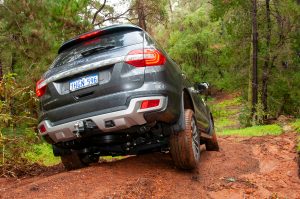
The molded contours of the colour-coded front and back bumpers flow seamlessly into the body line and are elegantly offset by a lower silver highlight front and rear, with the front housing an additional air dam and fog lights. There are modern bi-LED headlamps which provide good visibility on poorly lit back roads and a pair of bright LED daytime running lights to complete the front-end styling and provide the perfect addition for safety on a cold, wet and grey wintery morning.
The smart looking 20-inch polished alloy dress rims wrapped in GoodYear Efficient Grip SUV highway terrain tyres measuring 265/50R20 are the standard option for the Titanium and offer a smooth and quiet ride on the road. However, if you intend on using the 4WDrive prowess of your new Everest for something a little more adventurous than an easy run across manicured gravel access roads to your favorite winery, then the no cost option to switch to the 18-inch alloy rim and tyre package will be a much better option.
Finishing off the Titanium’s posh exterior styling is a pair of wide decorative sidesteps offering convenient ingress into the vehicle, but little else. Given their lightweight construction, they are not designed to provide any protection for the vehicle’s sill panel.
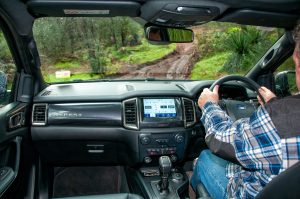
No matter which way you look at the Everest, it’s a formidable vehicle with substantial external dimensions. Yet it carries it well, and its impressive bulk is somehow reassuring, providing the impression of strength and certainty for protecting its occupants against the elements. Little had I realised that mother nature would provide an opportunity to test the Everest’s resolve in some challenging conditions.
Climb inside the Titanium and it’s comfortable and roomy for both front and second row passengers. Even the third-row seating could accommodate adults for a brief period but are best left to the younger and more energetic members of the family. What I did like was the stadium style has each row slightly higher than the one in front, providing great visibility for everyone.
Ford have done a great job of making the interior feel more upmarket with tactile soft surfaces, highlighted stitching and carefully colour-coordinated highlights providing pleasing tonal contrasts throughout the cabin. But it doesn’t totally cover the underlying commercial foundation acquired from its utilitarian counterpart, the Ranger. What is well accepted in a ute doesn’t necessary translate to the best form and fit for an upmarket family SUV—especially given this was the Titanium edition.
A larger speedo features in the center of the dash with two smaller combination screens to the side which display vehicle information and driver data on various safety features. Having to scroll through one of the screens to obtain a small tacho display seemed superfluous and rather annoying.
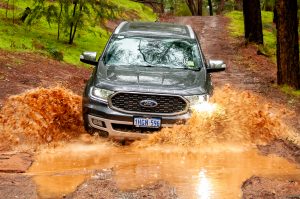
Switch controls vary in their presentation and are sometimes at odds with the rest of the cabin. The HVAC interface on the center dash console looks dated and a bit of an afterthought given the rest of the cabin styling. Fortunately, you can operate what functions you need from the touch screen interface as well. The icons displayed on the rotary dial for selecting the terrain looked like mirror copies from Land Rover, a possible design carry over from when Ford held the reins.
Fold down the seats and the Everest’s interior is huge, allowing you to easily pack all your camping gear for a trip away, or plenty of boxes for a delivery, and even most of your furniture. Which is great given you’ll may be shifting house cause this whomper won’t fit into a standard suburban garage.
So, it’s big, bold, a little brash, offers shed-loads of room, good passenger accommodation and comfort and has an assertive stance in traffic as it fills the lane with its rotund dimensions. It’s fair to say, there’s slim chance you’ll miss one coming toward you or driving next to you and I reckon it’s one of the better-looking SUV tanks around.
But what s it like on the road? The short version… very good. The Everest is a consummate mile eater. This is a vehicle the whole family will enjoy, the longer the distance the better. You’ll arrive at your destination feeling relaxed and contented, rather than flustered or aching from being bounced around the cabin like ping pong balls in a lottery machine.
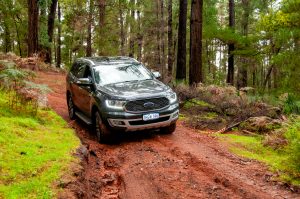
Keeping in mind this is a big comfortable people-mover makes discussing on-road handling and performance dynamics a moot point. This is a vehicle in which you feel comfortable and relaxed as you glide along, eating up huge distances with ease as the scenery slips past your quiet and serene carriage. You can enjoy a softly spoken conversation or a rather good audio system without the need to rock the speakers in their mounting cradles. Even spinning it around in a car park is relatively easy given its snug 11.8m turning circle and electrically assisted steering.
The Titanium also comes with Ford’s high tech bi-turbo diesel bolted up to a 10-speed auto, offering several spare ratios in case you lose one or two. As fussy as it might sound and while it might seem overly complicated to address the standard application of changing gears; the 10-speed has some very clever tech to exploit the diesel’s work ethics and give this bear of a vehicle a respectable turn of speed and acceleration when needed. Sports car, no… athletic cruiser, kind of.
The suspension soaks up most road bumps and dips with ease, never really impacting the serenity of the cabin, and cruising at highway speed is a joy. Should you be so inclined on winding roads, you can reduce the upper range of gears letting you keep the diesel in a spritely rev range for undulating terrain. I enjoyed watching the auto cleverly alternate the appropriate ratio pending speed and throttle application. Do we need 10 speeds in a road car? I’m not so sure. But having the best ratio to extend the narrow performance band of smaller, more environmentally friendly power plants can’t be a bad thing.
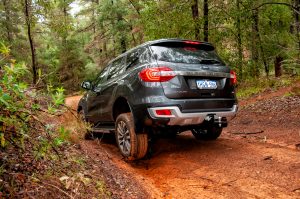
With more sting in the tail to stay relevant in fast-paced traffic, where does that leave this newer high-tech Everest for towing? On paper, there is the suggestion of all round improvement—but theory seldom reflects actual real-world experience because with so many rapidly changing variables and conditions it’s near-on impossible to duplicate performance on a nice shiny dyno in controlled temperatures. But that’s why there was extensive R&D testing on the Everest’s driveline to ensure it can deliver what’s on the box. Just have a gander at what driveline Ford chose to place under their steroid fed beef cake, gym junkie dual cab, the Ford Raptor.
Engine toque is up from 470Nm to 500Nm. There’s 157kWs on tap as opposed to 143kWs. Even the rated tow capacity has jump a modest 100kg. I’ve not towed with the newer 2L, but the way an engine delivers its torque is either low down and slowly over a broad rpm range or all in a short neck-snapping burst. Which does have an impact on the towing characteristics. I can’t help but feel the welcome gains in street drivability and performance of the spirited 2L, will demonstrate unique behavior changes on the relaxed towing character of its predecessor, the venerable 3.2L five cylinder.
Ford claim 7L/100km, down on the older 3.2L five cylinder’s 8.5L/100km. Given we averaged 8.1L/100km through city, highway and moderate off-road excursions, that will still see you safely towards a decent 1,000km touring range. Always keep in mind that hooking up the family accommodation on wheels and you’ll quickly trim that down proportionally to the amount of weight and wind resistance you place behind.
With Perth having seen relentless rain for over a week, the once pretty forestry trails were waterlogged and covered in a skim of clay and mud, making traction for our alluring 20-inch rims wrapped in rubber slicks awkward at best. This was the ideal opportunity to test the effectiveness of Ford’s Terrain Management System.
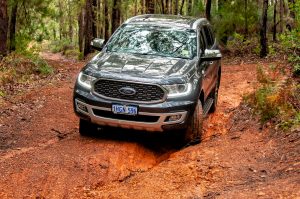
With four modes to choose from—normal, snow/mud/grass, sand or rock mode which needs you to select low range. With each different mode the vehicle will adjust the operation of the electronic stability control, and traction control whilst balancing throttle response, and transmission shift points. Not wishing to slide our way through as I prefer to drive a chosen line, I engaged snow/mud/grass and the system worked fervently to maintain forward momentum on the greasy tracks, intervening to control wheel slip and adjust throttle response to better suit the slippery conditions.
With 227mm of ground clearance, an approach, ramp over and departure of 29.5, 21.5 and 25 degrees respectively and an impressive 800mm wading depth the Everest is no wall flower when it comes to off-road awareness. Working in unison with Ford’s clever torque on demand system, the Everest will automatically adjust the amount of available torque between the front and rear axles sending the majority of power to the wheels with the greatest grip. The system can even allocate 100% drive to a single wheel should all three others have a complete loss of traction.
Several times I thought the system would struggle, seeing the need to engage the factory standard rear diff lock for greater assistance through deeper cross-ups. But with smooth steady throttle application and allowing the system to make calculated adjustments the Everest slowed, hesitated, and then determinedly moved forward. An impressive effort indeed with just road tyres.
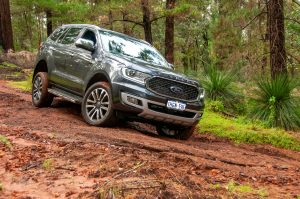
As the rain began to fall and puddles where rapidly forming lakes, it was time to plan a strategic retreat and head for terra firma before the Everest’s footwear succumbed to the laws of physics.
But driving along the back roads, the wind whipped up, small branches from roadside shrubbery were blown across the road and the rain hit with brutal force. Coming horizontally across the fields, the wind gusts buffeted the Everest side on, visibility dropped to almost nothing as everything become a monotone grey. Sections of the road were submerged with no edge markings or kerbs visible for directional reference other than those further ahead that hadn’t yet succumbed to the deluge of water. Despite what was unfolding around me, the Everest felt remarkably steady and composed; and I was deeply thankful not to be driving a smaller vehicle.
With all the latest in vehicle tech and safety systems that are expected in this segment, and a five-star ANCAP safety rating, Ford have done a reasonable job of converting the Ford Ranger into a practical and functional family wagon. What it lacks in finesse and refinements to totally separate it from its commercial DNA underpinnings is also where its hidden strengths in durability and capability lie. As a large comfortable touring wagon, it ticks a lot of check boxes. It also has intrinsic appeal and practicality needed to meet the demands of the modern growing active family.
But here’s the kicker, this understated wagon clearly demonstrated it has significant hidden talent for off road adventure just ready and waiting for its owner to unlock it.
Fast Facts:
Price: $73,490
Engine: 2.0-litre four-cylinder Bi Turbo-diesel
Output: 157kW/450Nm
Transmission: Ten-speed automatic
Fuel: 7.0L/100km
Safety rating ANCAP 5 Stars.


